Staying true to Gabrielle-Suzanne Barbot de Villeneuve’s 1740 “tale as old as time”, and in keeping with the 1991 animated film, under the direction of Bill Condon and starring Emma Watson and Dan Stevens, Disney’s BEAUTY AND THE BEAST gets a 21st-century story update by screenwriters Stephen Chbosky and Evan Spiliotopoulos. But along with an updating of the story and our heroine Belle, comes beautiful and breathtaking imagery, reflective in a true marriage between production design-costume design-cinematography. It is this triumvirate that makes BEAUTY AND THE BEAST as magnificent as it is.
Production Designer Sarah Greenwood creates a set that is lush, rich, textured, and extraordinary with imagination and detail. Cinematographer Tobias Schliessler’s cinematography, and particularly the lighting, constantly changes, capturing the beauty and texture of the production design while complementing the story and character development. But what Schliessler’s camera also showcases is the costuming by JACQUELINE DURRAN which is, in a word, WOW!
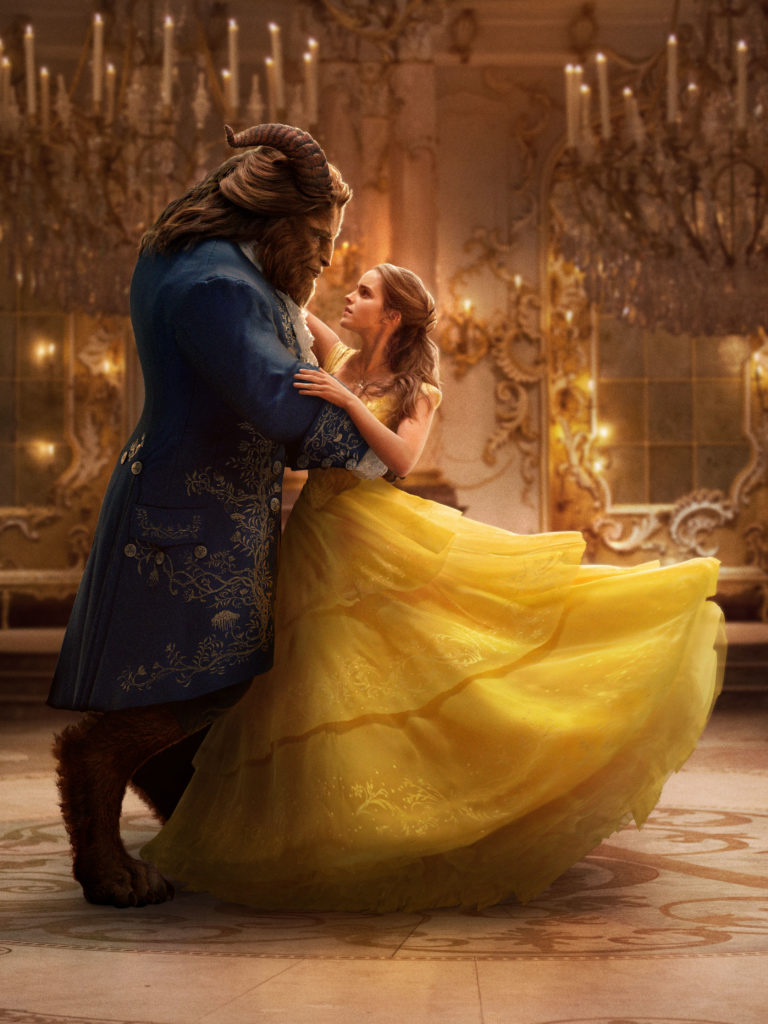
With four Oscar nominations already to her credit and one win for Best Costume Design for “Anna Karenina”, not to mention six BAFTA nominations and two wins plus countless other awards over the years, BEAUTY AND THE BEAST should lead JAQUELINE DURRAN to the winner’s circle again this year. Her designs are sumptuous, textured, and rich, weaving their own layer of storytelling into Condon’s overall tapestry. Color is the metaphoric king in Durran’s BATB designs with the continual thread of blue tying Belle and the Beast, as well as the signature yellow dress emblazoned with the Beast’s gold. The thread between the two characters ties them together from beginning to end. The tattered clothes of the Beast also follow through with darker blue. As we saw in “Cinderella”, this collaboration/partnership between Disney and Swarovski again delivers it’s own added beauty to Durran’s work from the the Prince’s embroidered and crystalled coat to Belle’s ethereal organza ball gown complete with over 2100 crystals. The detail to costuming, not only for period authenticity but little things like embroidery ribbons and bows, decolletage ruffles and petticoats, buttons and shoes, are standout and complete the immersion into this world which is a perfect meld of reality and fantasy. Not to be overlooked is Belle’s wedding/celebration gown. The floral print on white is perfect. And again, back to Schliessler’ lensing and lighting – we casually see the details as she waltzes.
Speaking with BEAUTY AND THE BEAST costume designer JACQUELINE DURRAN in this exclusive interview, she discusses the challenges and considerations in taking iconic costume images from the animated film and not only translating them to live-action but giving them a life of their own while being steeped in historical reference and influence. And what would a Disney fantasy be without yards and yards of the finest fabrics and craftsmanship from the world’s finest artisans?
Jacqueline, I absolutely love this film on every level. The costuming is exquisite. I was at the press day in Los Angeles and Belle’s yellow gown was displayed along with the Beast’s beautiful muted dark blue brocade suit. As beautiful as everything looks on screen, in person it was even more so. What you have done in translating the animated film into live action is outstanding. You retain the iconic elements that the whole world loves but you gave it a contemporary human feel. And that’s not always easy to do.
Oh, thank you. That’s great. It wasn’t easy, but I didn’t vary from that position. I didn’t want to reinvent the wheel. I wanted to use the animation, which was so great, as a starting point. I felt that if you didn’t do that, you were just going to disappoint people because it’s so loved and it’s so popular and it’s kind of the core of the whole, not of the whole movie, but the core of the whole costuming. People would expect the yellow dress. They would expect the blue dress. There’s things about it that are just really key themes, I think. People are so familiar with them. So I really wanted to do that. I didn’t stray away too far from that but you couldn’t just actually reproduce it because there’s not that much detail when you look at it. It’s really simple costuming in the animation, so we had to add to it and make it like real clothes. The place I looked for inspiration was 18th century France because the movies is set in 18th century France. The animation isn’t particularly historical, so I thought that the way to do it would be to bring in elements from history to augment the costume. But I also I wanted people to like the costumes and relate to them. I didn’t want to make them too strange or too period. We’ve cheated with elements that weren’t exactly right, but we’ve taken inspiration from history.
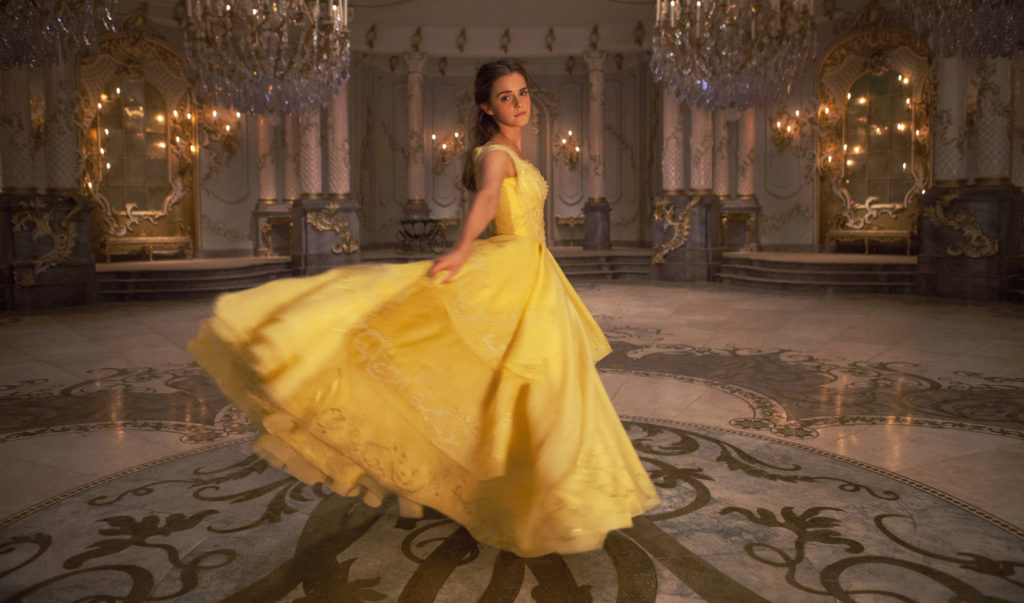
Something that I thought was particularly effective that you did was with the use of color. So many people, particularly with the yellow gown, identify with that iconic, that specific yellow color. Not just any yellow color, THAT yellow color. How does the color factor, the animated color factor, come into play when you are sourcing your fabrics?
We had to have the fabric made. We wound up in Italy for the color. We camera tested lots of different yellows because there’s totally different elements. There’s the yellow that is the animation, and how it looks in the room to the eye. There’s the yellow and the look with the lighting and there’s the yellow that is worn by Belle. But all of those things have to be taken into consideration because the yellow had to look good in the lighting. It had to appear to be like the animation but it wasn’t necessarily like the animation because of the lighting. So we had all these different things to consider. It took quite a while to work out what that yellow dress was going to be. It went through quite a few iterations. It went to being a much more modern style. We tried a much more historical style. We tried different fabrics. We tried all sorts of things. And in the end, it again comes back to the feeling of the animation and just a slight interpretation of the original animated costume was the one to go for because it was the one that really, when you saw it, you felt it was the yellow dress. When we’re trying to be too experimental with the shape or change it too much we just, it didn’t feel right. I think that that was our kind of guidance.

You’ve also got 2100 Swarovski crystals on that yellow gown. You come off of a film like “Macbeth” or “Mr. Turner” and you’re not using Swarovski crystals in those costumes. Is that fun for you, when you get to add the glitter and the glitz?
It is really fun. And what I really enjoy about it is it gives you the opportunity to work with really talented people who have all these skills. You have people that come and work with Swarovski and you have people that cut ball gowns and you have all these skills where on a smaller movie you can never afford to have the range of people working in your workroom. That you can have on a Disney movie. So you really can choose real artisans to come and work with you which is such a great pleasure. To work with people that are great makers, great embroiderers, it’s really a pleasure.

I’m glad you mentioned the embroidery because we have embroidery that follows through on everything; on the bodices of Belle’s clothes, for example. Be it the dark red bodice, the white one with the blue and red florals. Be it, her wedding gown. The embroidery goes everywhere. But hand in hand with that, it is very much the same design that Sarah Greenwood has on the floor of the ballroom.
The ballroom floor is – well not exactly – but we took the inspirations for the print. The gold that descends from the ceiling and swirls around the dress that Garderobe gives the final finishing touch to the dress. That gold pattern is based on the gold pattern from the ballroom floor. And the whole thing was about the costumes, Belle’s dress and the Beast’s costume at the same time for the dance, we really wanted it to feel like the things in the castle, the objects, were making these clothes for them because they so much wanted it to all work. So the makeover was made by them. So, the Beast’s coat was blue, as in the animation, but instead of embroidering it like the Prince’s coat at the beginning of the movie, we screen printed, then touched up, we painted the design on the coat. And that was because we didn’t want it to be a fully embroidered coat. We could have done that but we wanted it to seem like Plumette [Gugu Mbatha-Raw] might have done it. They knew what the coat should look like and with the skills they had in the castle as objects, they had made that coat for the Beast to dress him up as well as they could. The same was for Belle’s dress. It was really a corset but there was a timeless relationship between the castle which after all, was alive, and the clothes that they were wearing at that moment.
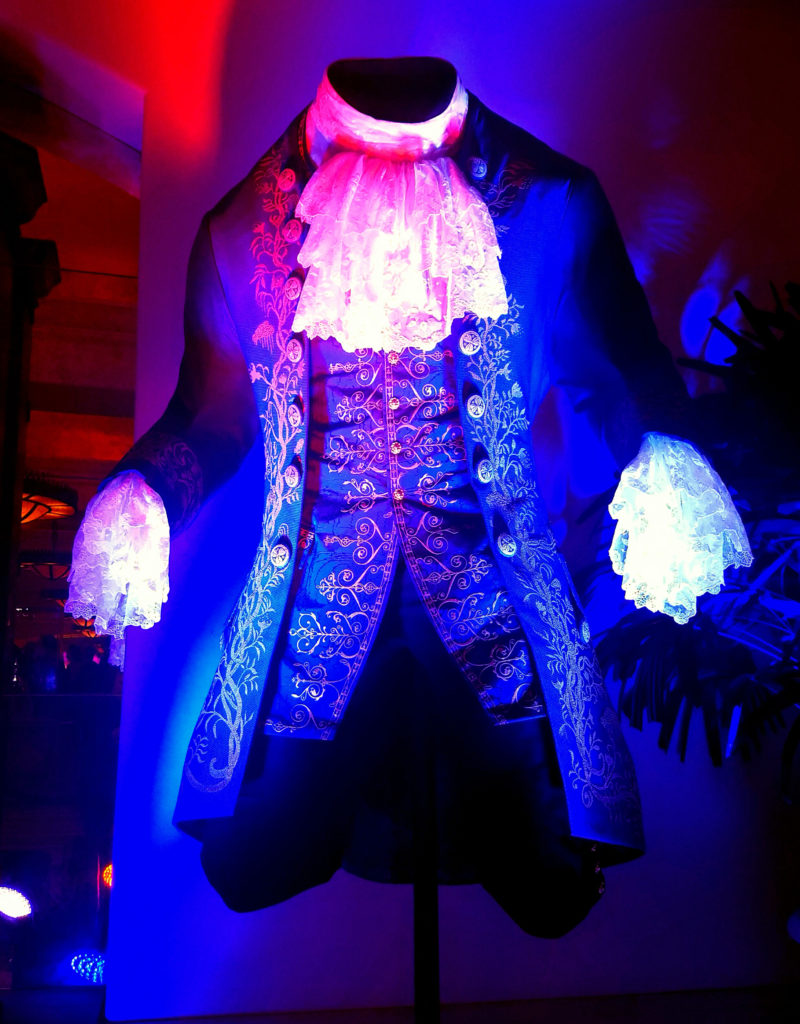
It’s exquisite. And with the Beast’s coat, I am just amazed that that’s a screen printing on there because it looks like a brocade fabric.
It was quite hard to do that. We had a few false starts but I was really pleased with it in the end. And I was really pleased with the idea of doing that because I just felt that it gives you a reason to make changes between the costume and gets to the story that relates to the story. I was just really pleased about that. Embroidery does run through the jacket that [Belle] wears. Now, I can’t remember the scene but when she goes to Paris with the Beast, because of the nature of Belle, no one’s ever asked about this actually, with the embroidery we took all kinds of stylized images of animals and we embroidered animals because she loved animals so much and birds. We took 18th-century style animal images and embroidered them on the jacket. You barely see it, so, it was a lot of work.

Well, it’s all well worth it when you look at the total picture and the metaphor and the level of storytelling that the costuming tells in a film like this. I was talking with Tobias Schliesser the other day, and was saying this has to be one of the most collaborative and synergistic filmmaking processes between costuming, production design, and cinematography that I have seen in quite awhile because each is so interdependent upon on the other, in this film.
That is absolutely true. And that’s also what makes it so enjoyable to do because you’re really linking and pulling everything together. It’s a much more fulfilling process than working in isolation.

And speaking of the collaboration, one of the most striking scenes in the film is the film opening with the huge dance that the Prince is having and you see all of this. At first blush, it appears everybody’s in white, but on closer inspection, there’s a tiny little bit of crème infused in the white or a tiny little bit of ecru. How did you go about designing that whole grouping of costumes? Also, designing the costumes of the human counterparts of our castle objects? With those costumes, I think people overlook the painstaking detail and, of course, to find white costumes that are all different, slightly different shades? That was mind-boggling to me.
It is actually a huge amount of work and I don’t think anyone really realizes because it happens so fast on screen and it’s gone. It was 60 white dresses. 18th-century dresses are a big amount of work because there’s the construction of them and there’s the detailing and the decorations. Even on a Disney movie we didn’t have that much money so we had to find lots of different silks available in shade of crème, ecru, white, not so much white [but] more slightly off-white. So we gathered up from all the silk merchants all the silks that we could find in our budget. And then we divided up with lots of costume houses around Europe – Spain, Italy, London. The different costume houses made 10 dresses each. And they sent the dresses back to us. They didn’t decorate them because again, because of time and money. Then we had a work crew at the studio that just did the decoration of the 18th-century dresses. We applied lace, frills, Swarovski crystals, everything to those dresses to give them some kind of detailing.
They’re absolutely stunning. And the way Tobias lenses them is just gorgeous! And as I watched it, it’s like alright, I know budgeting can be constraining, I know you can’t go overboard with this many costumes, but I also know you didn’t make these out of muslin.
We really made them out of silk but we had to go to all the silk merchants and say “What’s your end of the line? What have you got?” You know just gather it up. We couldn’t just go and say “Okay we’re going to take 1000 meters of your crème silk.” We had to go around finding suppliers that had some odd pieces left. I was quite determined we would stick to our kind principles and get silk and get the color. It would just look different if we hadn’t used silk.

That, and the camera would have picked it up. Because of Tobias’s lighting, and especially with so much candlelight and the overhead candelabra, you would have seen it on screen and it would have looked cheap and [producer] Todd Lieberman would not have been happy.
Todd Lieberman was actually there on the day! He said, “This is amazing! Well done!”

Speaking to the human dressing of our objects within the castle, Audra McDonald’s gown is over the top, very operatic in its design. Emma Thompson’s is a little more subdued. You’ve got little iridescent shades within the fabric of like a soft peach. Stanley Tucci is overdone in gold. How did you go about designing those costumes to suit the personalities because each one is so distinctive yet fit in the period and in the fantasy?
By the time I joined they had already designed the objects pretty much. They were close to getting final approval on the objects. So, I knew, for instance, Madame Garderobe [Audra McDonald] was going to be that color and and she was going to have gold detailing and she had to be big and she had to be operatic. So I worked again, between the guidance I was getting for the objects and the repeating of the Disney animation and history and tried to kind of combine the elements. Take the gold details, 18th-century furniture, and think how would you translate that to the dress, and just work like that. Really piecing the different things together and taking inspiration from each part. Again, it was really collaborative. The pattern on Emma Thompson’s [Mrs. Potts] dress is an interpretation of the pattern that is on the teapot. We really did try to tick those boxes and those connections. And again, you know, they’re on camera for such a short time, but I think hopefully that it registers.
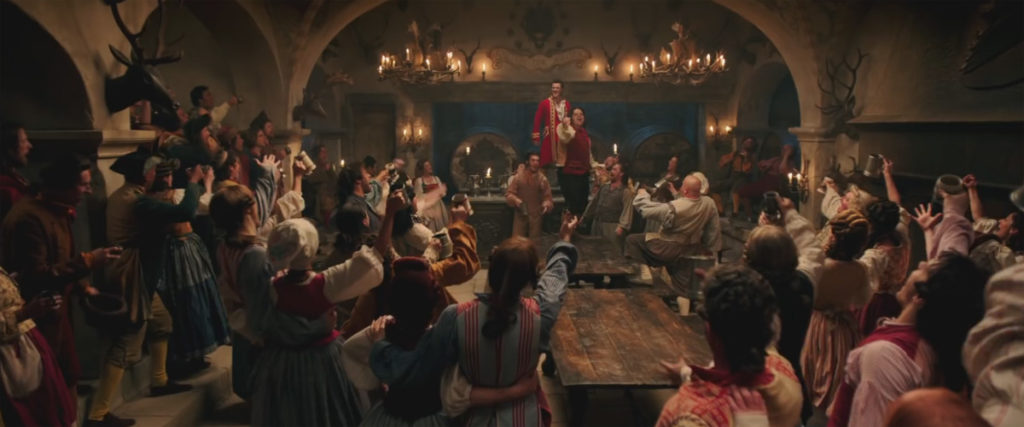
I have always been fascinated by costume and thanks to my own background have always been very cognizant of the fabrications and the costume design. I see these little details that you incorporated here and I am just blown away that you made, with the castle a living and breathing thing, the costumes are living and breathing things with your design.
That was really what we hoped to get over. And the thing is, it’s so rich cinematically as a story. You know, to have a castle that is alive and growing and magical. It’s such a great idea and it’s one that really lends itself to interpreting clothes in the way Sarah [Greenwood] did the production design, and presumably, Tobias [Schliesser] as well.
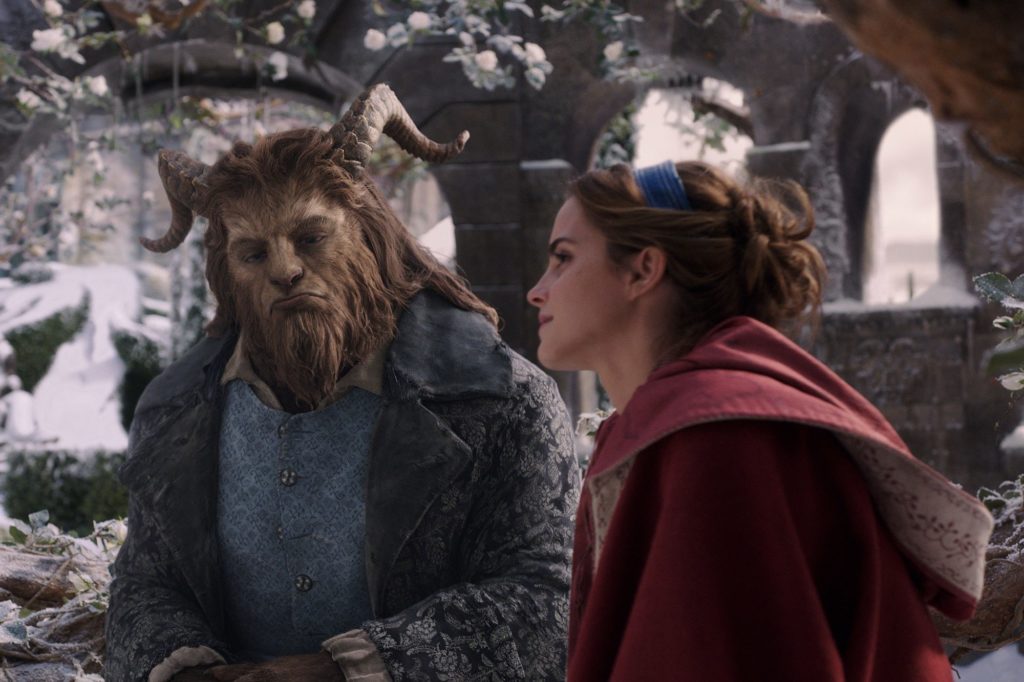
I know Tobias just loved working with you and Sarah. Just loved it.
That’s great. I did, too. It was a special job. It had so many elements. It had the debutante’s dance as you say at the beginning, but one of my favorite parts is the opening of the village. When Belle comes out and walks through the village, you suddenly get this feeling of what the village looks like in the patterns and the colors and everything else. I was really pleased at how that worked out. And again that was taking inspiration from the French provencal fabrics, printed poplin, and working that into this sort of Disney idea of the village.
How many costumes did you have to design and create, Jacqueline?
I’m not sure. One of my assistants was asked for a number and she said that we did over 500. I didn’t do it on my own. I had lots of people to help.

Disney princesses and heroines are known for their beautiful “wedding” gowns. I would be remiss not to ask you about the exquisite final gown, white gown, with all the embroidery of nature all over it.
It’s actually printed, the final dress. But one of the things about it was that Emma [Watson] didn’t want the finale to be a wedding. She wanted it not to be a wedding dress. She wanted it to be patterned enough that people wouldn’t think it was a wedding because she didn’t want the end of the story as her being married in the sense that that was all that Belle had ever been aiming for. That didn’t seem to her to be the thing, that that would be the final fulfillment for Belle. I don’t know if I’m expressing that correctly, but you know what I mean? She didn’t want that to be the grand finale. So she wanted it to be a party and a celebration. So we called it the “Celebration Dress”. In order to get over this problem, again it was about combining the elements. so we wanted the dress to be distinctly different to the yellow one, to be a kind of a new situation. So we went with white. I think it was just the general feeling of being dressed up and repeating the white theme.
I had an apron that I’d had since I was a student. It was a woven 18th-century pattern and it was a really beautiful floral print. I got someone to take that pattern and make it into a screen and then we played around with how large and bold the pattern would be and how small and the colors. And we played around with making it, all the different layers, so that you could have one layer silk organza or another, or print on another layer above it. We just played around with layering the pattern. Again, the whole scene was so floral. They had those big chains of flowers hanging down from the ceiling and it was like a very grand village celebration. So, the natural flower imagery seemed the way to go in contrast to the cold beginning with the Prince. The opposite of the Debutantes Ball.
Very much so. And when you look, when you compare the bookends, when you look at the final chapter as opposed to the first chapter, that also adds more to the fact that you went with the off-white shadings because everything was a little muddy in the Prince’s world at that time. There was no clarity.
It works. You can read it however you want, you know? It’s not so far from being [a wedding dress], that it’s difficult to see it like that way, but at the same time it gives Emma some leeway for her interpretation.
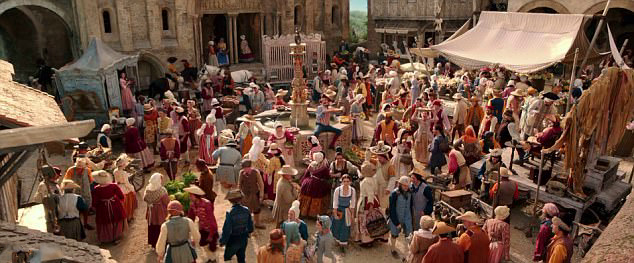
Before I let you go, Jacqueline, I’ve got to ask you what it is about costume design, what is the gift that it gives you, that keeps you going? The lessons that you learned with BEAUTY AND THE BEAST that you can take forward into your future works?
That’s a really difficult question. The thing that I like doing is, I like teasing out kind of the theme that I want to bring to it. And I like to listen to the director and try to work out what it really is that he wants the costumes to express, what color, where he wants them to be. Sometimes people don’t tell you exactly what they want. So, to really get an idea of the director’s vision and then bring all the actors to that table so that we’re all kind of working together to get one vision, that’s the thing that I find most thrilling. It’s kind of problem solving, the combinations and elements. The way the actors want their character to be. The way the director sees the film. The way the DP sees the film. Just bringing all those elements together and really working with every interpretation that is good for everybody. That’s what I really enjoy. The thing that gives you the most challenge in bringing those elements together is the most interesting. And this was great for that. There were so many themes that you could follow and so many connections that you could bring to the surface. That was really enjoyable. What I take forward? I don’t know what I take forward really. I don’t know. I just keep hoping that I’ll get better. I don’t really know what I take forward. I think with experience you gain confidence and in that respect it becomes more enjoyable because you feel more confident in bringing your ideas to the table, and your interpretation. So that always makes things more pleasurable.
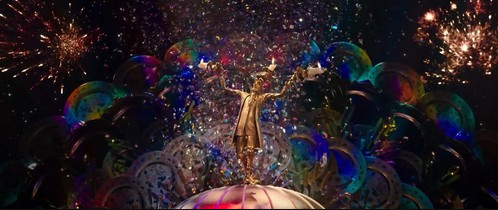
Jacqueline, again, congratulations. What you brought to the table, what you brought to the screen, what you brought to our imaginations with BEAUTY AND THE BEAST is all simply exquisite.
Thank you so much. That’s really really kind, thank you. I’m really pleased. That was the thing. Even when we saw the movie and we felt, as the filmmakers, that we’d done the right thing, there was no way that we could really call it until the audience had seen it and people responded to it. It was a movie that was really important. It was key to what we were doing that we would fulfill the fans expectations. I think that was really important for me. Disney really wasn’t the world I grew up with. I’m just a bit older than the demographic of the Disney revival in the late 80’s. I was already too grown up to watch Disney. But I really wanted to meet their expectations.
I think you exceeded the expectations of Disney and the audience. As long as we have you and Colleen Atwood and Sandy Powell around, Disney is in good hands for flights of fancy, fantasy, and history.
by debbie elias, interview 10/24/2017












